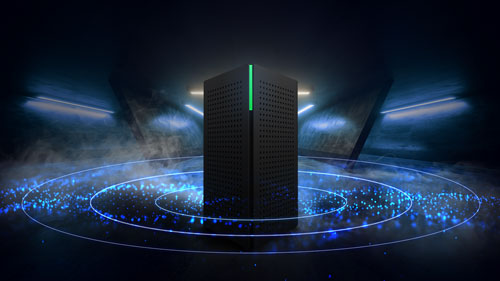Our technicians and support team often throw out terms like “wireless interference,” “channel congestion,” and “big red showdown.” Except for that last one, it can be a little confusing. We live in a fiber-focused world, and it’s easy to forget that not everyone shares our enthusiastic obsession with all things tech. So let’s take a moment to really dive into wireless devices, their capabilities, and their downfalls.
Nearly all of our customers connect to the internet via a wireless interface or, as most folks call it, Wi-Fi. Routers have internal wireless antennas for the signal to broadcast at a frequency accessible to every Wi-Fi-enabled device within range.
Our ALLO Blast router has two radio frequencies: 2.4GHz and 5GHz, to connect your web cameras, smart TVs, mobile phones, and more. Many, but not all, devices take advantage of the 5GHz band for better bandwidth with little to no interference when in close range. On the flip side, the 2.4GHz has a more extensive range with lower bandwidth. Need to move from room to room? No problemo! Newer devices around your home will switch from 5GHz to 2.4GHz without skipping a beat.

We recommend the 5GHz if you’re close to the router for the ultimate experience on newer devices. Other devices like that 10-year-old laptop from college operate wonderfully on the 2.4GHz. You might hear a 2.4GHz frequency called an ‘unlicensed band’ or ‘consumer band’. If you’re looking for a great question to stump someone on game night, it’s technically called ISM (Industrial, Scientific, and Medical). All electronics emitting any radio signal are required to operate within this band.
Many homes and businesses contain, what we in the internet biz like to call Wi-Fi haters. They’re often totally natural and unassuming items but they can be a major Wi-Fi buzzkill.
Sometimes we hear reports from customers about a totally normal connection and signal strength that suddenly drops out of nowhere for short bursts of time. This is when we ask about the environment and try to see if we can pin the issue on frequency interference which is a fancy way of saying, “your microwave makes a mean burrito, but it’s killing your signal.” Ordinary household items like microwaves, cordless phones, wireless speakers, fluorescent lights, baby monitors, and garage door openers can significantly impact your experience. These gadgets often operate on a 2.4 GHz spectrum with a farther reception and transmission range that leads to congestion. That’s what we call ‘interference’.
Did you know all sorts of devices can emit radio waves in the 2.4GHz frequency band even if they don’t have Wi-Fi? That’s because of strict regulations on frequency emissions to prevent interference on critical systems that rely on dedicated and regulated frequencies. The 5GHz devices, on the other hand, have an allowance for close proximity or short-range connectivity within federal guidelines, which also means interference will be lower.
Those common household devices are only part of the problem. Can you guess what the others are? We’ll take building materials for 500 Alex! The offenders vary depending on the age of the structure and whether it’s a home or apartment. Lathing and stucco walls, support beams, furniture, cabinets, and shelving near your router can severely impact your Wi-Fi. It’s why sometimes the signal can be better in one room over another. Once you rearrange the furniture, it works flawlessly. Electrical panels and wiring inside of walls can add to the issue too. If we rated them on the Wi-Fi hater scale it would look something like the chart below.

Less common barriers include hearing aids, power lines, railway tracks, power stations, and (are you ready for this one?) your hand. Some reports show that when positioned in precisely the wrong spot, your grip can affect Wi-Fi performance, and a simple position change can sometimes be an easy fix.
So how do we keep interference low? The answer? Location, location, location. Placing the router inside a closet or cabinet, putting something around it, or even hiding the device behind a TV can negatively impact signal strength and reliability. During installation, your technician will guide you on the best home for your equipment to limit interference.
Although our fiber-optic network and equipment are pushing out some of the fastest available internet speeds on the planet, various other factors could infringe on your otherwise flawless fiber experience.
For example, you may need a wireless extender if your wireless experience is excellent in most of your home except a specific room like the basement or garage. A wireless extender may be helpful in multi-level and split-level homes, uniquely shaped homes, attached and detached garages, and backyard gathering spaces. Or your TV box may need to be connected directly to the router to guarantee a better experience if the Wi-Fi is excellent, but one TV with a wireless TV box buffers.
Our goal at ALLO is to make sure you have an exceptional experience. Please let us know if you notice service that is anything but stellar. Our team is happy to help you resolve any issues.










